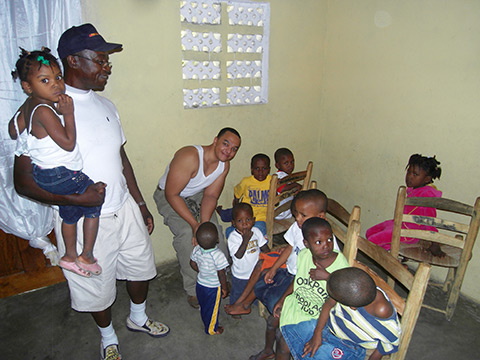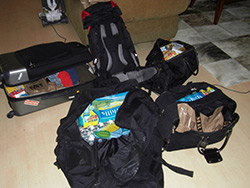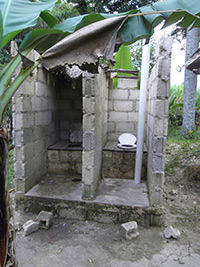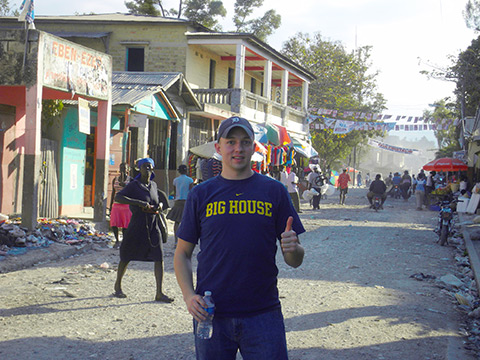
Carl L. Works introducing his son Carl I. Ross-Works to some of the children his organizations are helping in Haiti.
Any general aviation pilot who has wanted to take action to help ease the suffering in earthquake-stricken Haiti but doesn’t know how might want to talk to Carl Works.
Works, an AOPA member from Pompano Beach, Fla., is the founder of Walk in the Light Ministries International, and Walking with Hope Charities International. Active in Haiti before last year’s earthquake, his organizations’ projects now support three orphanages, two schools, and a medical clinic in the devastated Caribbean nation.
 In the airport in Fort Lauderdale, Fla.
In the airport in Fort Lauderdale, Fla.
When the earthquake struck, “I watched the help come in with the TV cameras, and then leave just as fast,” he said in a recent e-mail message to AOPA urging pilots to get involved in continuing relief work. On Jan. 13, 2010, AOPA reported on relief efforts that had begun soon after the earthquake, when estimates of the toll were only beginning to emerge. Flights continued well into March as pilots flying everything from piston singles to turboprop cabin aircraft flew aid and rescue missions to Port-au-Prince, Cap-Haitien, and then on to interior destinations. (See the March 2010 AOPA Pilot feature “Flying into Haiti: The best of general aviation in the worst of times.”
While the world’s attention has turned to other matters, conditions for the average Haitian have worsened, Works said. Infrastructure remains devastated. A pervasive fear of cholera, and political instability connected to the incomplete presidential election process that began with voting on Nov. 28, have combined to bring many Haitians to the brink of despair.
The problem now isn’t marshalling food, medicine, and supplies from sources in the United States. The difficulty is getting it where it’s needed in Haiti, and getting Haitians to the care they need. That’s where Works believes that general aviation pilots could come in. Pilots volunteering to transport workers, children in medical need, and equipment could “do some great things to save the country.”
 Carl I. Ross-Works and Derrick Quant, both of Navistar International, in the hills overlooking Port-au-Prince.
Carl I. Ross-Works and Derrick Quant, both of Navistar International, in the hills overlooking Port-au-Prince.
With Port-au-Prince now “a nightmare” and reconstruction virtually paralyzed, Works sees a pressing need for organizers to “think outside the city.” He suggests that several outlying airports could serve as ports of entry for inbound pilot-volunteers. That was possible during the first few weeks after the earthquake, but when normal international flight procedures were resumed in March, general aviation relief flights wound down, despite a continuing need, as AOPA reported on March 11, 2010.
Works is trying to work out Customs arrangements with officials. Back in Port-au-Prince some relief items have sat for a month or more without being cleared. The problem is twofold: the backlog, and the corruption.
Works says he is “talking to anybody and everybody within reason” to find a better way.
With donated items of food and clothing flowing in as a result of media reports of the projects, he is searching for hangar space in Haiti where a base of operations could be established, and in Pompano Beach or at Fort Lauderdale Executive airports in Florida.
“My greatest fear is that a child we are caring for will need medical help and die because we can’t get them out to help,” he said. “I have seen people die standing in line waiting for assistance.”
With needed help only 90 minutes away by aircraft, Works vows that not a single one of the children, now numbering about 700, in the orphanages’ care will be lost. Obstacles are daunting under current conditions; it takes about an hour and a half in an emergency to transport a child from one of the orphanages, located in the mountains, to Port-au-Prince, where treatment remains “hit or miss.” What makes the adverse logistics so tragic is that most patients are “completely savable” if they get help in time.
 This bathroom serves 42 children and staff.
This bathroom serves 42 children and staff.
With conditions in the country “getting worse by the minute,” Works worries about “more of a feeling of impending violence than there has been in a long time” in Haiti. And with water supplies for many people “sporadic”—and water a primary conduit for cholera outbreaks—there’s now “a paranoia that will lead to hysteria about cholera.”
“If anything happens the country will shut down completely,” he says. “The U.S. will have to step in, without a doubt.”
Works, whose operations have expanded to the care of some Haitian refugees in the Dominican Republic, urges any general aviation pilot who wants to participate in relief operations to take a commercial flight with him to Haiti. The offer includes going over charts and discussing the ins and outs of flying within the country. Interested pilots can contact him by e-mail.
“Come see what you’d be flying into,” he says.

Quant in Dumerville, Haiti. The group tried to find building supplies locally.
Flights still saving lives in Haiti
By: Dan Namowitz
A year after the Haiti earthquake devastated the Caribbean nation and set off worldwide efforts to provide relief to victims, a Nampa, Idaho-based organization continues to fly missions that confront changing and growing logistical challenges.
Mission Aviation Fellowship is flying at full capacity in Haiti on missions now designed to fight cholera, provide relief, and aid the rebuilding of the country—its role made even more necessary by the “compromised” state of the country’s infrastructure, said MAF President John Boyd.
“While the earthquake grabbed all the major headlines, 2010 has been a disaster-filled year for the impoverished Caribbean nation. Haiti has also suffered from Hurricane Tomas, a cholera outbreak that has killed an estimated 3,300 people and hospitalized more than 100,000, and political upheaval that has at times stifled Port-au-Prince and surrounding cities,” he said in a Jan. 5 news release.
MAF has been present in Haiti since 1986 and has four aircraft based at the Port-au-Prince airport.
“Every week we are called upon to transport work teams and building supplies, or special equipment like water purification systems,” Boyd said. MAF flies to about 16 airstrips in Haiti, and recently added an aircraft to its fleet to cope with the growing demands.
MAF’s Haiti staff also recently took its work in a new direction, building homes for families whose houses had collapsed in the earthquake.
“Through gifts from generous donors, MAF purchased 26 pre-fabricated structures and built them on the existing foundations. Though small by U.S. standards, the houses are well-anchored, sturdy and much appreciated by the families that were previously living in tents,” said MAF.
The organization estimated that more than a million Haitians were still living in tent cities as the Jan. 12 anniversary of the earthquake approached.



